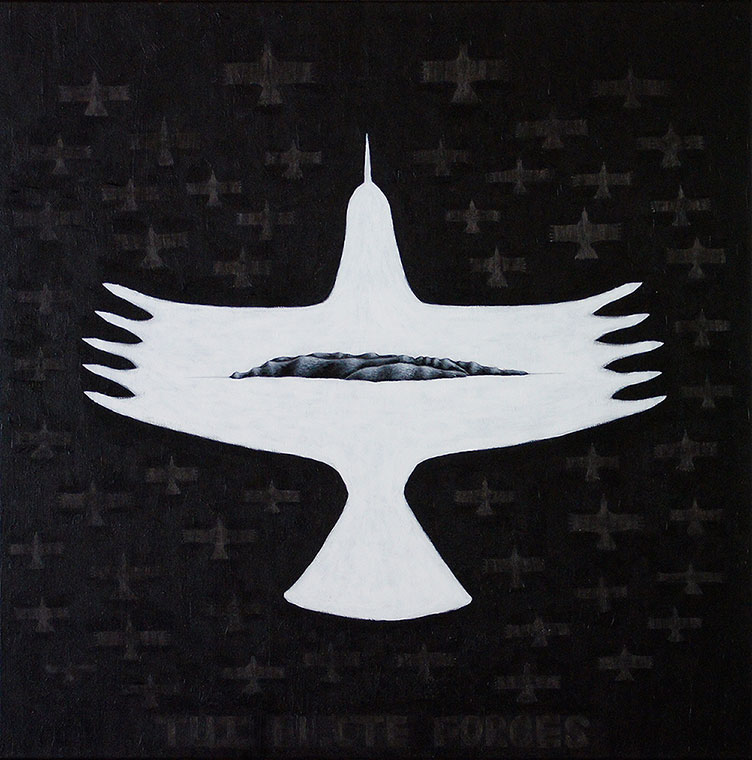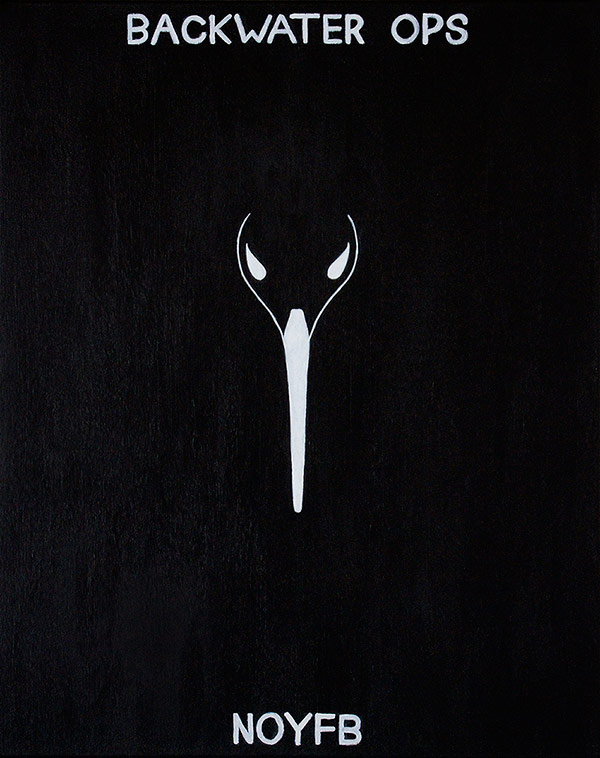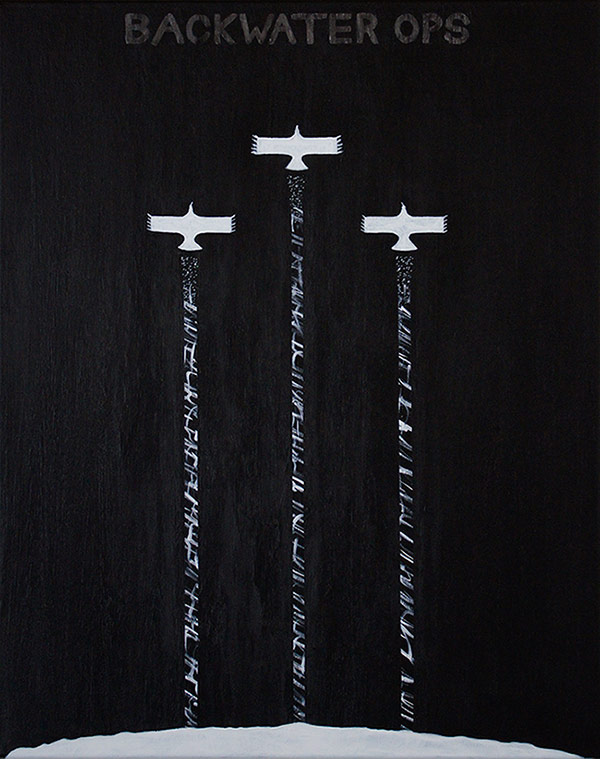Below are some notes on ideas and influences associated with my recent Backwater Ops series. While not exhaustive, they represent some of my intentions and thoughts when making the work.
Backwater
Most viewers are unlikely to get this reference, but for me the series title Backwater Ops is partly a play on Blackwater, which was the name of a private military firm (later changed to Academi). Blackwater is also the title of a bestselling book about that secretive company, or rather mercenary army, by investigative journalist Jeremy Scahill. The book details how Blackwater became one of the most powerful players in the Iraq War, and in the ongoing War on Terror in many countries.
Scahill went on to co-found The Intercept with well known investigative journalist Glenn Greenwald and documentary filmmaker Laura Poitras. They were the people Edward Snowden entrusted to reveal his leaked NSA documents to a shocked world. These leaks revealed how the NSA, along with its international Five Eyes spy agency partners, including New Zealand’s GCSB, had in secret been building the largest and most pervasive infrastructure for mass surveillance the world has ever known.
More obviously than the Blackwater reference, I also chose the title Backwater Ops to allude to New Zealand’s involvement in this international spy alliance. No doubt New Zealand plays a small but important role in the five-country Five Eyes network, but it can be considered a backwater compared to the military intelligence might of the US and UK.
In social media I have jokingly referred to New Zealand as being at the very end of the internet, an internet backwater, but of course everyone online is now connected by mere moments, whatever their geographical location. Although internet communication is close to instant now, in an increasingly globalised world, including the art world, New Zealand can still be considered a backwater. It’s far away from the major “art centres” such as New York, London, and Berlin. However, although remote, a backwater can be used to create and hold important secrets, and to develop secret projects, out of view from prying eyes.

Post-Snowden
Like many people around the world, I was shocked to learn of Edward Snowden’s revelations about the Five Eyes alliance and its extensive, ever-growing surveillance capabilities. I was transfixed by the regular articles from The Intercept, mainly by Glenn Greenwald, and the world’s reactions to Snowden’s leaks. The internet has become a huge part of our daily lives, and the new knowledge that government spy agencies were using it to conduct mass surveillance worldwide made people realise that the supposedly democratic internet had changed dramatically; it had become militarised.
Immediately before my Backwater Ops series, in late 2013 and early 2014, when the public debate surrounding spy agencies and mass surveillance was in full swing internationally, I created a couple of works on the Five Eyes theme. These works included an outdoor guerrilla artwork at the landing point of New Zealand’s only undersea internet cable (see Five Eyes Network – Outpost and Five Eyes Network – Outpost). Snowden’s leaks had revealed the Five Eyes intention to tap the massive amount of data running through this Southern Cross cable. It was not clear how far that work had progressed, or if it had already being carried out. After the Snowden leaks, many assumed it was already happening.
Secret Military Patches
I want to mention the influence of the work of American artist, geographer, and author Trevor Paglan on my Backwater Ops series. Before making this work, I had read his book I Could Tell You But Then You Would Have to be Destroyed by Me. The book takes a look at the US military’s secret projects, which of course the rest of the world is not supposed to know anything about. Although top secret, it seems the military still creates identifying patches (worn on military uniforms) for these top secret ops.
Like my Backwater Ops paintings, these real military patches offer some cryptic clues about the nature of the classified projects they represent. The imagery is often aggressive, sinister, full of military bravado, yet often cartoonish. Paglan’s book documents a collection of more than 70 patches representing secret military projects, including secret weapons projects, intelligence operations, and secret aircraft squadrons. Often the patches use animal graphics, and of course nationalistic emblems.
These weird but real patches were partly a springboard for my approach to the Backwater Ops paintings. I began asking myself questions: as a Five Eyes partner, what if little Aotearoa New Zealand in the South Pacific also undertook top secret military projects, and produced imagery to do with these? What might that imagery look like? Further, what might the imagery look like if society took a distinctly dystopian path, where total surveillance and authoritarian rule became an everyday reality?
Backwater Ops is the result. It deals with an imagined, dystopian national identity. Like the real military patches Paglan collects, I’ve made use of some iconic national wildlife – tui, huia, tuatara, kiwi, kokako, ruru – as well as some other familiar national emblems and landscape imagery.

Wildlife and Environment
In the work, some of New Zealand’s iconic birds, the ancient tuatara, and an indigenous bat, have been transformed into authoritarian emblems representing a malevolent future. The Tui Elite Forces patrol a local landscape (Auckland’s Waitakere Ranges) like surveillance drones. The secret mission assigned to the native bat is to Collect All Signals All The Time. According to the classified NSA documents leaked by Edward Snowden, this is a stated goal of the NSA. In another work, a sinister, waspish emblem ominously states: Let Them Hate, So Long As They Fear. This well known quote is attributed to Roman Emperor Caligula and still surfaces from time to time in relation to tyrannical regimes and individuals.
The kōkako is heroically surviving Against All Odds. In this dystopian future, the struggling kōkako has been appropriated as an emblem of state and military survival. However, in Huia Forest Forces the (extinct) huia has had its military Operations Terminated.
The nocturnal and secretive ruru (or morepork) proclaims We Own The Night, and the prehistoric tuatara warns you to Keep Your Distance – as the public is cautioned to do in real life for reasons of conservation of the species. The secretive, and most iconic of all, kiwi bluntly announces in internet and texting shorthand that its Backwater Ops mission is simply NOYFB: None of Your Fucking Business.



